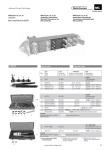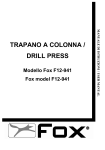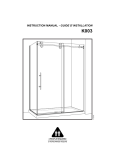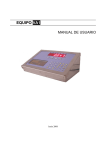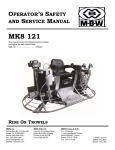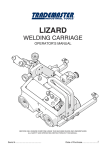Download Bolton Tools BT1340G/1 Specifications
Transcript
ZX45A POWER FEED BENCH MILLING&DRILLING MACHINE OPERATING MANUAL CONTENTS SAFETY WARNING---------------------------3 SPECIFICATION----------------------------4 FEATURES---------------------------------5 INSTALLATION-----------------------------6 OPERATION--------------------------------6 ELECTRICAL SYSTEM------------------------9 TROUBLE SHOOTING-------------------------10 MAINTENANCE------------------------------11 2 SAFETY WARNING 1. READ ALL INSTRUCTIONS BEFORE USING THIS MACHINE 2. KEEP GUARDS IN PLACE AND IN WORKING ORDER 3. KEEP WORK AREA CLEAN, CLUTTERED AREA INVITE INJURIES 4. KEEP CHILDREN AND VISITORS AWAY FROM WORK AREA 5. DRESS PROPERLY, NO LOOSE CLOTHING, GLOVES NECKTIES,OR OTHER JEWELRY TO GET CAUGHT IN MOVING PARTS,WEAR PROTECTIVE HAIR COVERING TO CONTAIN LONG HAIR. 6. ALWAYS WEAR EYE PROTECTION, ALSO USE FACE OR DUST MASK IF OPERATION IS DUSTY. 7. REMOVE ADJUSTING KEYS AND WRENCHES FROM TOOL BEFORE STARTING. 8. BE SURE DRILL BIT OR CUTTING TOOL IS SECURELY LOCKED IN THE CHUCK. 9. AVOID UNINTENTIONAL STARTING 10. KEEP PROPER FOOTING AND BALANCE AT ALL TIMES,DO NOT REACH OVER OR ACROSS RUNNING MACHINES. 11. MAINTAIN TOOLS WITH CARE, KEEP TOOLS SHARP AND CLEAN FOR BETTER AND SAFER PERFORMANCE 12. DO NOT OPERATE THIS MACHINE WHILE THE INFLUENCE OF DRUG, ALCOHOL OR ANY MEDICATION 13. USE THE RIGHT TOOL FOR THE JOB.DO NOT ATTEMPT TO FORCE A SMALL TOOL OR ATTACHMENT TO DO THE WORK OF A LARGER INDUSTRIAL TOOL. 14. ENSURE THIS MACHINE IS PROPERLY GROUNDED 15. SECURE WORKPIECE TO KEEP WORKPIECE FROM ROTATING WITH THE DRILL BIT OR CUTTING TOOL 3 SPECIFICATION Model Max.drilling capacity Max.face mill capacity Max.end mill capacity Max.tapping capacity Max.spindle stroke Swivel angle of headstock at perpendicular direction Max.distance between spindle nose to table Distance between axes of spindle to Column slide Spindle taper Working area of table Forward and backward travel of table Left and right travel of table Spindle speeds (4P) Main motor ZX45A 1 7/9″ 3 1/7″ 1 1/9″ M12 5 1/8″ ±90° 15 5/9″ 10 1/4″ M.T.4 OR R8 31 1/2″×9 4/9″ 6 1/2″ 17 5/7″ 50HZ 80,145,260,375,710,1250 RPM 60HZ 95,175,310,450,850,1500 RPM 1.5KW 1400RPM 0.25KW 33 1/4″ 35 5/6″ 40 1/6″ 345kg/395kg Wrench MAG 24 Allen wrench1/8, 1/6, 1/5, 1/4 Screwdriver(-)6″ Drill stock Wedge Drawbar Drawbar washer Power Speed Feed motor Length Width Overall height (without stand) Net weight/gross weight Standard accessories 4 FEATURES (1) This machine may be used for surface cutting, drilling, milling, boring and tapping. (2) This machine is of fine quality, can be operated easily, it is not limited to skilled operator. (3) The drilling and milling operation can be performed by two methods: 1)Hand operation, which makes quick feeding drilling or slow feeding milling 2)Auto-feed operation, the machine have six different feeding for drilling. (4) Many of the adjustable nuts are bronze, for adjusting thread clearance and reducing wear. these bronze parts also allow screws to rotate smoothly and improve accuracy. (5) The vertical column is very strong and stiff, which makes the machine very stable and improves accuracy of manufactured parts. (6) The machine headstock is cast iron, it has been heat-treated, stress-relieved, and precision machined. (7) Machine gears are ground for smooth operation. (8) Speeds and feeding can be easily changed. (9) Tapping can be done in either rotation, working depth can be controlled by using a positive stop gauge. (10)The head can be turned in two rotation for a satisfying desired angle. INSTALLATION (1) Ensure the headstock is as lower as possible, and be fixed on the column tightly before moving machine. while moving machine, keep its balance and safety. (2) Don’t mount the machine at the sunshine place to avoid the deformity of machine and the loss of accuracy. (3) Mount machine to a sturdy table or a solid concrete foundation, it’s advisable that the base you choose be well constructed to avoid any vibration during operation. (4) Thoroughly clean the machine with a commercial degreaser, and then coat all bright metal with a light lubricant to prevent corrosion. (5) Level the surface of the worktable on both lengthwise and crosswise by using a precision level. (6)Remove the oil filler plug and fill the oil to the gear box until the oil level reaches the middle of the oil fluid level indicator. Lubricate all 5 points OPERATION Notice: Check all parts and safety precautions for proper condition before operation 1.Change speed handle 2.Feed handle 3.micro feed knob 4.Crank 5.Longitudinal handwheel 6.Cross auto-feed handle 7.Cross lock handle 8.Longitudinal lock handle 9.Longitudinal autofeed handle 10.Cross handwheel 11.Change table feeding knob 12. Quick-feed handle 13. Adjust positive stop gauge knob 14.Rack quill lock handle 15.Change spindle feeding Knob 16.Electric box 17.Positive depth stop gauge 1. Use of main machine parts (1)Raise and lower the headstock on its rack and pinion mechanism by using the crank(4). when the desired height is reached, tighten the bolts to avoid vibration. (2)Head may be rotated 180°by loosening the three lock nuts. Adjust the head to the desired angle, then tighten the heavy duty head lock nuts. (3)The knobs is setted for MILLING & DRILLING, TAPPING ,STOP AND TABLE FEED. The mushroom head red push button for emergency stop while milling and drilling, the green push button for starting. (4)When hand-feeding the spindle, push the feed handle(2) in; and micro-feeding the spindle, push the handle(2) out, turn the knob(15) to “0” position, then operate the knob(3).when auto-feeding the spindle, turn the knob(3)to select a mount of feeding. (5)Move the table from side to side by using longitudinal handwheel(5), and from front to back by using the cross handwheel(10). 6 (6)Adjust the positive depth stop gauge(17) according to working depth. (7)When move the table by hand, adjust longitudinal/cross auto-feed handle(6,9) to middle position, then turn the longitudinal/cross handweel(5,10) to move the table. When move the table by power,open the switch for table feed, turn the knob(11) to select the amount of feed at first,then, press down the handle(9) to turn left for longitudinal moving the table left, press down the handle(9) to turn right for longitudinal moving the table right. Press left the handle(6) to turn up for cross moving the table forward, Press left the handle(6) to turn down for cross moving the table backward. When the handle(6 or 9) is on the working state, press down the quick-feed handle(12) to make longitudinal/cross quick feed .Trips of table are controlled by limiting position block. 2. Drilling operation (1)For drilling blind hole (which do not pass through the workpiece), push the feed handle(2) in,then adjust the positive depth stop gauge(17) so that the distance from the tip of the drilling bit to the end of the blind hole is equal to the desired depth. (2)For drillling pass hole(which pass through the workpiece),set the positive depth stop gauge in its uppermost position. 3. Milling operation (1)Adjust the positive depth stop gauge to its uppermost position (2)Using the spindle feed handle(2), adjust the cutter to approximately the correct height, push the handle(2) out. (3)Set the working depth by using the micro feed knob(3). (4) Lock the rack sleeve at the height with the fixed bolt. (5) When longitudinal feeding milling,it is a good idea to lock the across feeding table to ensure the accuracy of your work. To do this, tighten the two screws(7) located on the right side of the table base. (6) When cross feeding milling, lock the longitudinal feeding travel, do this by tightening the two screws(8) on the front of the table base. 4. Tapping operation (1)Push the feed handle(2) in (2)Adjust the positive depth gauge to the required position. (3)The switch point to “tapping”. When tapping is overload, press down the red emergency switch, and the spindle reverse, the taper turn out. 5. Adjustment (1)Adjustable moveable fixed rings are mounted on the front of the table to limit cross travel. (2)Your machine is equipped with gib strip adjustment to compensate for wear and excess slack on cross and longitudinal travel. (3)Rotate the gib strip bolt slightly clockwise to tighten the gib trip. 7 rotate it slightly counter-clockwise to loosen the gib trip. (4)Adjust the gib trip bolt until very slight drag is felt when moving the table. 6. Changing machine speed (1)Turn the power off. (2)To select the proper speed, move the handle(1) to the desired position . (3)If the gear are not engaged, remove the arbor bolt cover. rotate the spindle slightly to engage the gears, then replace the arbor bolt cover. (4)Recheck the handle setting, then turn the power on. RPM HZ 50HZ 60HZ 80 95 145 175 260 310 375 450 710 850 1250 1500 7.Installing and changing tools WARNING: BE SURE THE POWER IS TURNED OFF AND THE MACHINE UNPLUGGED BEFORE INSTALLING OR CHANGING TOOL BITS. (1)Removing face mill or drill chuck arbor. Loosen the arbor bolt at the top of the spindle shaft approximately 2 turns with a wrench.rap the top of the arbor bolt with a mallet. After taper has been broken loose, holding chuck arbor on a hand and turn the arbor bolt with the other hand. (2)To install face mill or cutter arbor Insert cutter and cutter arbor into the taper of spindle. Tighten arbor bolt securely, but do not overtighten. (3)Removing taper drills (a) Turn down the arbor bolt and insert the taper drill into the spindle shaft. (b) Turn down the rack sleeve until the oblong hole in the rack sleeve appears, lock the rack sleeve, insert wedge though holes and strike lightly with a mallet, this will force the taper drill out. 8.Ordering replacement parts Complete parts list is attached , if parts are needed, contact your local distributor. 9.Additional tools and accessories you will find helping Each of machine is equipped with a M.T.3 or R8 ,contact your local distributor or a main cutting tool distributor to obtain any of these accessories. Taper drill Reamers 8 End mills Cutter arbor Taps Collets Adapters and sleeves 10.Specification of the T-slot Please refer to figure, purchase or make T-bolts and other table top fixtures to these dimensions. ELECTRICAL SYSTEM WARNING: 1.A fuse must be connected between machine and power. 2.The ground terminal of machine must be grounded properly 3.Don’t open electrical box during operation,if something is wrong with machine, please ask repairman for help. SPECIFICATIONS OF THE FUSE Voltage phase Single phase 110V 20A 220V 10A 380V Three phase 5A 5A THREE PHASE CIRCUIT 9 SINGLE PHASE CIRCUIT TROUBLE SHOOTING 1.The machine doesn’t run when the power switch is turned ON (a)The knob is in the STOP position (b)A fuse has burned out---Check in the switch box, and replace it necessary. (c)If there is a surge in the current, the circuit breaker may have opened---Press the circuit breaker back, if it is in the open position. (d)The gear may not be engaged---Adjust the speed lever to be sure it is engaged. 2.The motor overheats, or there is insufficient power (a)The machine is overloaded---Reduce the load of feed. (b)The voltage supply is too low---provide with a reliable power supply. (c)The switch may have a burned or broken contact point---Replace the switch. (d)The contactor relay may be broken---Replace it. (e)There may be a poor electrical connection. Have a qualified electrician check the wiring and power supply. (f)The motor is poor---replace with new one. (g)The drill bit or cutting blade may be worn---Sharpen or replace the bits as needed. 3.The spindle bearing is very hot. (a)There is insufficient lubrication---Turn off the power,and check the bearing for lubrication. If necessary, apply bearing grease. 10 (b)The spindle bearing is worn, or is fixed too tight---Turn off the power, unplug the electrical connection, and rotate the spindle by hand.Be sure it freely. If not, adjustment the bearing .If you feel no use in the bearing, you will have to replace it. (c)The spindle has been turning at high speed for a long time---After Long use, turn the machine off for a while to give it a rest, and allow it to cool off. 4.Table travel is not balanced (a) The gap of the table guide is too wide or feel a heavy drag when moving the table---Adjust gib strip in proper (b) The locked bolts may be loose---Check and tighten them if necessary. (c) The feed is too deep---Reduce the depth of cutting, make several passes to reach the required depth. 5.There is vibration, and roughness of working surface during performance. (a)The gap of spindle bearing is too wide---Adjust the gap in proper or replace bearing with new one. (b)Spindle loosening up and down---Check the adjustment of the two inner bearing covers. adjust them so there is no free play in the taper bearing, and the bearing turns freely. Tighten them against each other to save this adjustment. (c)The gap of the taper sliding plate is too wide---Adjust the bolt tension. (d)The chuck is loose---Tighten the chuck. (e)The drill bit or cutter is dull---Sharpen or replace it.be sure to use cutting fluid to preserve tool life. (f)The workpiece is not held firmly---Check the clamps or vise you are using, and assure to tighten the workpiece 6.The micro feed does not work smoothly (a)The clutch may be loose ---Check this and tighten if necessary. (b)The worm or worm shaft may be worn---Check these and replace if necessary (c)The handwheel fixed screw may be loose---Check it and tighten if necessary. 7.The workpiece is not machined accurately (a)Imbalance of heavy workpiece---Check to see that heavy workpiece are held in balance. the workpiece Out of balance may shift when being machined (b)A hammer has been used on the workpiece---never strike the workpiece with a hammer. (c)The table may not be level---check the table with a level to be sure it is level both side to side and front to back. 11 (d)The machine may not be stable in the floor--- be sure the machine is firmly mounted to the floor. MAINTENANCE 1.After each use (a) Turn off the power switch. (b) Remove any tool bits, clean and lubricate them, and return them to their storage case. (c) Using a stiff bristle brush, brush off all chips. (d) Using a rag, wipe off any excess or dirty oil or cutting fluid left on the machine. (e) Lubricate the points, apply light greese or oil to all unpainted metal to prevent corrosion. (f) Cover the machine to prevent dust or dirt contamination when not in use. 2.Daily maintenance (a) Fill the oil reservoir to the proper level before each use (b) Check the tightness of the bolts holding the head in place. (c) If overheating or unusual noises are produced, stop the machine immediately to check for lack of lubrication, faulty adjustments, dull tool bits or other deficiencies, correct any problems before resuming work. (d) Keep the work area clean. 3.Weekly maintenance (a) Clean and coat the lead screw with oil. (b) Check the lubrication of the sliding parts of the table. apply light greese if needed. 4.Monthly maintenance (a) Adjust the accuracy of the slides on both the cross and longitudinal feeding. (b) Lubricate the bearings, worm gear and worm shaft with light grease. 5.Yearly maintenance (a) Adjust the table to assure that it is level in all directions. (b) Check the electrical cord, plug, circuit breakers and related connections to assure that they are secure and safe. (c) Drain the lubricant from the gear box and replace it. 12












